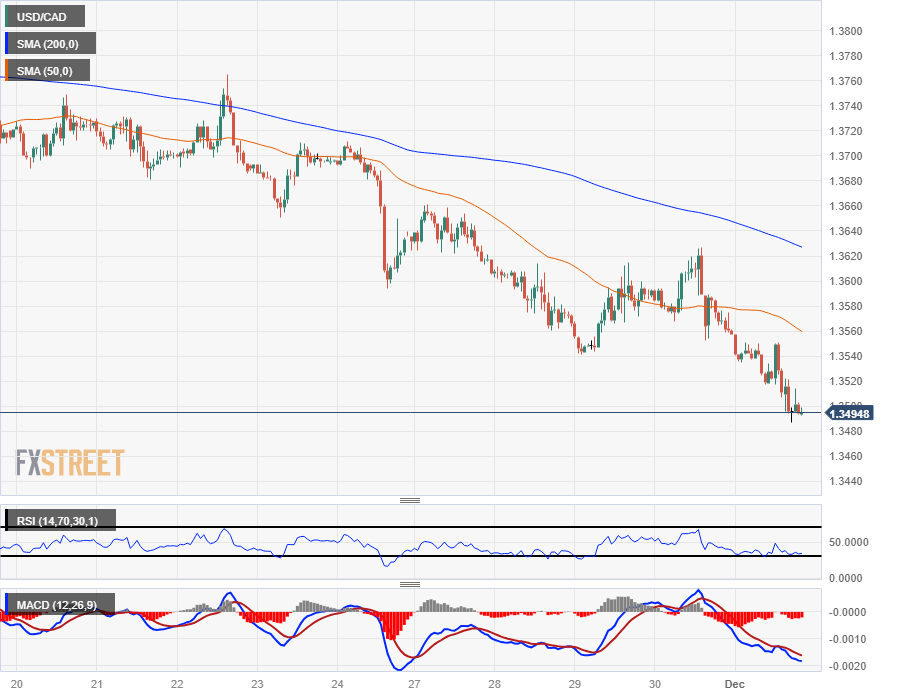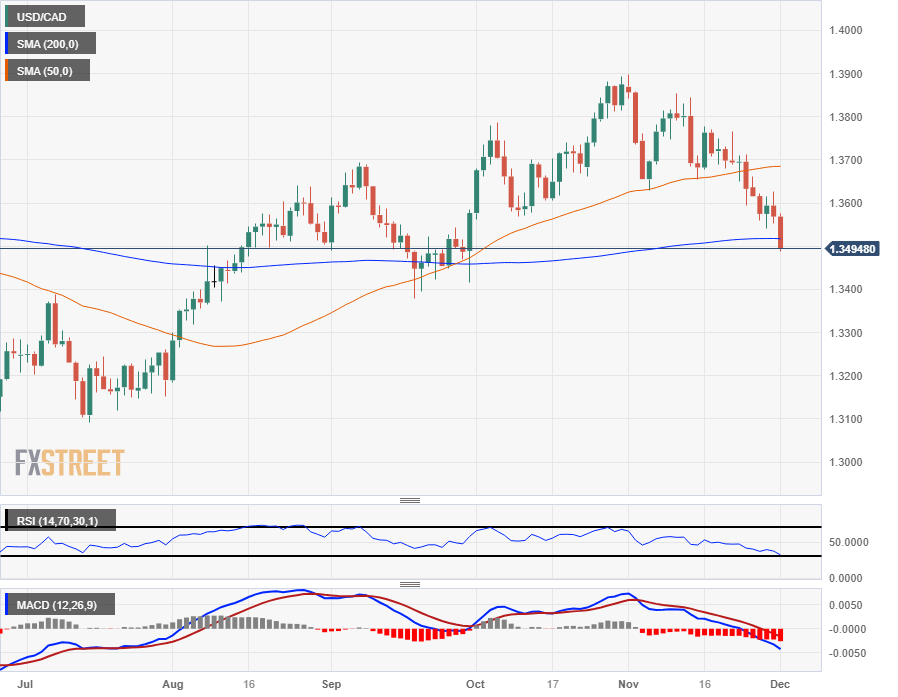Most recent article: Canadian Dollar slips as US Dollar rebounds to kick off another NFP week
- Canadian Dollar sees further gains heading into the end of the trading week.
- Canada's new job hiring outpaced market expectations, but the unemployment rate ticked slightly higher.
- Canadian wage growth holds steady at 5%.
The Canadian Dollar (CAD) is testing higher ground in Friday trading, climbing once more against its largest peer, the US Dollar (USD), after Canadian employment figures handily trounced market expectations. The Canadian Dollar is one of the top-performing currencies for the week, having gained a full percent against the US Dollar from Monday’s opening bids.
Canada added almost twice as many jobs as the median market forecast expected in November, showing almost 25K new hires against the forecast of 15K, increasing the pace of new job additions from October’s 17.5K.
The Canadian Unemployment Rate ticked slightly higher to 5.8%, in line with investor expectations, and Average Hourly Wages for the year into November held steady with October’s print of 5%, helping to ease demand-driven inflation concerns as Canadian wage growth remains capped under 6%.
Daily Digest Market Movers: Canadian Dollar is on the move against the US Dollar once more, challenging 1.3500
- The Canadian Dollar is up four-tenths of a percent against the US Dollar on Friday, gaining a full percent on the week.
- Canada added 24.9K jobs in November compared to the previous 17.5K, beating expectations of a 15K print.
- Despite beating market forecasts, Canadian hiring remains below 2023’s peak print of 150K in February.
- CAD supremacy is limited by a slight decline in the Canadian S&P Global Manufacturing Purchasing Managers Index (PMI), which slipped from 48.6 to 47.7.
- The Canadian Unemployment Rate slightly increased from 5.7% to 5.8%, but markets broadly anticipated this figure.
- The CAD is still shrugging off Thursday’s Gross Domestic Product (GDP) backslide after quarterly GDP unexpectedly declined 1.1% for the third quarter. Investors are instead focused on the extreme upside revision of 2Q’s GDP growth from -0.2% to 1.4%.
- Crude Oil markets are as volatile as ever but continue to range as fossil fuel investor sentiment plays tug-of-war between declining global demand concerns and a fresh batch of Organization of the Petroleum Exporting Countries (OPEC) Crude Oil production cuts set to continue through Q1 2024.
Canadian Dollar price this week
The table below shows the percentage change of Canadian Dollar (CAD) against listed major currencies this week. Canadian Dollar was the strongest against the Euro.
| USD | EUR | GBP | CAD | AUD | JPY | NZD | CHF | |
| USD | 0.56% | -0.84% | -1.01% | -1.41% | -1.87% | -2.10% | -1.48% | |
| EUR | -0.57% | -1.41% | -1.59% | -1.98% | -2.45% | -2.67% | -2.06% | |
| GBP | 0.84% | 1.39% | -0.16% | -0.56% | -1.01% | -1.23% | -0.64% | |
| CAD | 0.99% | 1.55% | 0.18% | -0.40% | -0.86% | -1.08% | -0.48% | |
| AUD | 1.39% | 1.94% | 0.54% | 0.39% | -0.46% | -0.67% | -0.07% | |
| JPY | 1.83% | 2.40% | 0.93% | 0.83% | 0.43% | -0.21% | 0.38% | |
| NZD | 2.05% | 2.61% | 1.21% | 1.05% | 0.67% | 0.22% | 0.56% | |
| CHF | 1.44% | 2.02% | 0.64% | 0.48% | 0.08% | -0.37% | -0.60% |
The heat map shows percentage changes of major currencies against each other. The base currency is picked from the left column, while the quote currency is picked from the top row. For example, if you pick the Euro from the left column and move along the horizontal line to the Japanese Yen, the percentage change displayed in the box will represent EUR (base)/JPY (quote).
Technical Analysis: Canadian Dollar pushing for an additional day of gains against the US Dollar
The Canadian Dollar (CAD) continued its climb against the US Dollar (USD) on Friday, sending the USD/CAD down to the 1.3500 handle in Friday trading, and the pair is currently snarled along the 200-day Simple Moving Average (SMA) near 1.3520.
The Canadian Dollar has climbed against the US Dollar for four of the last five consecutive trading days, and the USD/CAD is on pace to close out Friday action with one more down day as the pair trades into eight-week lows.
With the USD/CAD down nearly 3% from November’s early peak at the 1.3900 handle, technical indicators have accelerated firmly into oversold territory. The 14-day Relative Strength Index (RSI) is testing the lower, oversold bound, and the Moving Average Convergence-Divergence (MACD) signal line has rotated into negative territory.
USD/CAD Hourly Chart

USD/CAD Daily Chart

Canadian Dollar FAQs
What key factors drive the Canadian Dollar?
The key factors driving the Canadian Dollar (CAD) are the level of interest rates set by the Bank of Canada (BoC), the price of Oil, Canada’s largest export, the health of its economy, inflation and the Trade Balance, which is the difference between the value of Canada’s exports versus its imports. Other factors include market sentiment – whether investors are taking on more risky assets (risk-on) or seeking safe-havens (risk-off) – with risk-on being CAD-positive. As its largest trading partner, the health of the US economy is also a key factor influencing the Canadian Dollar.
How do the decisions of the Bank of Canada impact the Canadian Dollar?
The Bank of Canada (BoC) has a significant influence on the Canadian Dollar by setting the level of interest rates that banks can lend to one another. This influences the level of interest rates for everyone. The main goal of the BoC is to maintain inflation at 1-3% by adjusting interest rates up or down. Relatively higher interest rates tend to be positive for the CAD. The Bank of Canada can also use quantitative easing and tightening to influence credit conditions, with the former CAD-negative and the latter CAD-positive.
How does the price of Oil impact the Canadian Dollar?
The price of Oil is a key factor impacting the value of the Canadian Dollar. Petroleum is Canada’s biggest export, so Oil price tends to have an immediate impact on the CAD value. Generally, if Oil price rises CAD also goes up, as aggregate demand for the currency increases. The opposite is the case if the price of Oil falls. Higher Oil prices also tend to result in a greater likelihood of a positive Trade Balance, which is also supportive of the CAD.
How does inflation data impact the value of the Canadian Dollar?
While inflation had always traditionally been thought of as a negative factor for a currency since it lowers the value of money, the opposite has actually been the case in modern times with the relaxation of cross-border capital controls. Higher inflation tends to lead central banks to put up interest rates which attracts more capital inflows from global investors seeking a lucrative place to keep their money. This increases demand for the local currency, which in Canada’s case is the Canadian Dollar.
How does economic data influence the value of the Canadian Dollar?
Macroeconomic data releases gauge the health of the economy and can have an impact on the Canadian Dollar. Indicators such as GDP, Manufacturing and Services PMIs, employment, and consumer sentiment surveys can all influence the direction of the CAD. A strong economy is good for the Canadian Dollar. Not only does it attract more foreign investment but it may encourage the Bank of Canada to put up interest rates, leading to a stronger currency. If economic data is weak, however, the CAD is likely to fall.
Information on these pages contains forward-looking statements that involve risks and uncertainties. Markets and instruments profiled on this page are for informational purposes only and should not in any way come across as a recommendation to buy or sell in these assets. You should do your own thorough research before making any investment decisions. FXStreet does not in any way guarantee that this information is free from mistakes, errors, or material misstatements. It also does not guarantee that this information is of a timely nature. Investing in Open Markets involves a great deal of risk, including the loss of all or a portion of your investment, as well as emotional distress. All risks, losses and costs associated with investing, including total loss of principal, are your responsibility. The views and opinions expressed in this article are those of the authors and do not necessarily reflect the official policy or position of FXStreet nor its advertisers. The author will not be held responsible for information that is found at the end of links posted on this page.
If not otherwise explicitly mentioned in the body of the article, at the time of writing, the author has no position in any stock mentioned in this article and no business relationship with any company mentioned. The author has not received compensation for writing this article, other than from FXStreet.
FXStreet and the author do not provide personalized recommendations. The author makes no representations as to the accuracy, completeness, or suitability of this information. FXStreet and the author will not be liable for any errors, omissions or any losses, injuries or damages arising from this information and its display or use. Errors and omissions excepted.
The author and FXStreet are not registered investment advisors and nothing in this article is intended to be investment advice.
Recommended content
Editors’ Picks

EUR/USD extends recovery beyond 1.0400 amid Wall Street's turnaround
EUR/USD extends its recovery beyond 1.0400, helped by the better performance of Wall Street and softer-than-anticipated United States PCE inflation. Profit-taking ahead of the winter holidays also takes its toll.

GBP/USD nears 1.2600 on renewed USD weakness
GBP/USD extends its rebound from multi-month lows and approaches 1.2600. The US Dollar stays on the back foot after softer-than-expected PCE inflation data, helping the pair edge higher. Nevertheless, GBP/USD remains on track to end the week in negative territory.

Gold rises above $2,620 as US yields edge lower
Gold extends its daily rebound and trades above $2,620 on Friday. The benchmark 10-year US Treasury bond yield declines toward 4.5% following the PCE inflation data for November, helping XAU/USD stretch higher in the American session.

Bitcoin crashes to $96,000, altcoins bleed: Top trades for sidelined buyers
Bitcoin (BTC) slipped under the $100,000 milestone and touched the $96,000 level briefly on Friday, a sharp decline that has also hit hard prices of other altcoins and particularly meme coins.

Bank of England stays on hold, but a dovish front is building
Bank of England rates were maintained at 4.75% today, in line with expectations. However, the 6-3 vote split sent a moderately dovish signal to markets, prompting some dovish repricing and a weaker pound. We remain more dovish than market pricing for 2025.

Best Forex Brokers with Low Spreads
VERIFIED Low spreads are crucial for reducing trading costs. Explore top Forex brokers offering competitive spreads and high leverage. Compare options for EUR/USD, GBP/USD, USD/JPY, and Gold.